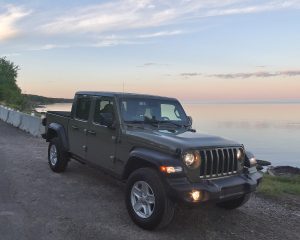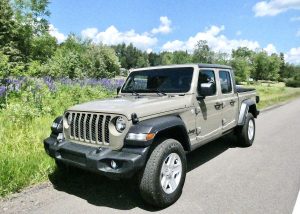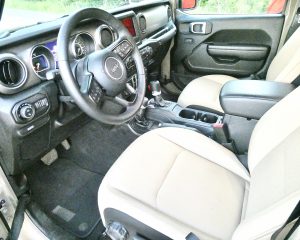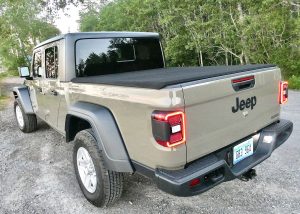Gladiator opens new doors for Jeep
By John Gilbert
The first time I saw a Jeep Gladiator in the flesh, it was almost surreal, as though I was looking at a cartoon and it suddenly sprang to life. Ever since World War II we’ve had Jeeps, best identified by the go-anywhere Wrangler, and the new Gladiator looked as though some Jeep designer thought he might play a prank by taking the rough, squarish outline of a Wrangler, fit a pickup bed on the rear, and put it out as a “concept car” to attract attention and stir conversation.
It’s possible that nobody at FCA (Fiat Chrysler Automobiles) would admit it if that were true, but if so, the resulting acclaim and fanfare from the public might have inspired FCA to order Jeep to make the vehicle.
At a large Midwest Auto Media gathering at Elkhart Lake, Wis., a year and a half ago, there was a prototype Gladiator there for us to drive, briefly, around the area highways. I did that, and was anxious to get my hands on one for a thorough test drive.
That took awhile, as in over a year, during which time demand skyrocketed and manufacturing took more time. By the time one was driven to my driveway up on the hill just north of Duluth, Minnesota, I was more than eager to get into it. Even then, the surreal overtones continued. It caught me off-guard, just by its color — “Gator” clear-coat — a most-unusual flat grey, unlike any gator I’ve ever seen, but certainly unique.
The Gladiator is not a scaled-up version of a Wrangler, as I had expected. It has its own chassis, and don’t forget parent FCA also makes the award-winning Ram pickups, which is where a lot of the Gladiator basics come from. A 4-door pickup Jeep, and the name Gladiator fits its aggressive outlook on life.
At that time, I hadn’t seen a Gladiator on area highways or in Duluth. I’m sure there must have been a visitor-driven model somewhere along the line, but we just hadn’t seen one. My first impression was that it lacked the steering tightness of the new Wrangler, and the slight looseness made you feel that you had to pay special attention to avoid wandering. That made it a little unsettling as my wife, Joan, and I took off for a drive up the North Shore of Lake Superior.
Among other bits of lunacy, our family has a tendency to humanize our vehicles, and in my case, it’s a frequent changeover because it’s important to spend my week-long road-tests immersed into whatever car I’m testing, to observe how it fits into our lifestyle. Sort of like a short-term adoption. Sometimes, it seems that the car takes control. I joke about how any car I’m driving prefers to cruise up the North Shore Drive, which takes us through the tiny sailboat haven of Knife River, Minnesota. As we drive through Knife River, whatever vehicle I’m driving takes over and turns immediately into the small parking area out front of the Great! Lakes Candy Company. I’m powerless to prevent it. And why would I?
On that day in the Gladiator, it happened, and it just turned in, and parked, so we could follow the coronavirus protocol to submit our order online, via my iPhone, to get a selection of the absolute best homemade chocolate stuff, in this case, dark chocolate covered almonds with tiny toffee bits imbedded in the chocolate, and some almond bark. Once submitted, you get a response time for when the staff will set out a white paper bag with your name on it on a front porch table.
We were waiting for our proper time to arrive as we sat in the Gator Gladiator, when a white vehicle pulled in and parked alongside us. It was a husband and wife, driving a pure white Gladiator. You want surreal? We hadn’t seen a Gladiator in real-world driving, and here were two of them, identical, next to each other. They wanted to try the candy shop and didn’t understand the online bit, and I was unsuccessful helping them put in an order, even though I stressed that if they tried it, I knew they would be coming back.
We did, however, get the opportunity to compare Gladiators. We had a nice conversation, and I asked the fellow driving how he liked his new vehicle. He loved it. I asked if he had the 3.6-liter V6 engine, and he did. I told him that I had also driven the Wrangler, on which the Gladiator is loosely fashioned, and in it you can get the new 2.0-liter turbocharged 4, which has a lot of power and could easily handle the Gladiator, plus get better fuel economy. He said he would prefer the 3.6 anyway, because he and his wife haul a camping trailer and the extra torque of the V6 is a big benefit for ease of towing. In fact, it has the most towing capability in its segment.
The rare opportunity to interview someone driving the same vehicle I was testing prompted me to obtain a scouting report, about various issues I had heard might discourage some buyers. What about the ride: Is it too harsh?; some thought there might be a lack of refinement; there was some suggestion that the difficulty in building the Gladiator as a compromise between a smooth family vehicle and a rugged off-roader might have missed on one extreme or the other. But my new acquaintance denied any of those things were valid complaints, in his experience. Valuable input.
With that, the fellow and his wife headed back to their North Shore campsite in the White Gladiator, and we took our bag of homemade dark chocolate confections, and headed up the Shore in the Gator-colored Gladiator.
His input backed me off a bit, and as a few days passed, I found the initial looseness less of an issue, probably because I became accustomed to it with a few days’ experience.
Room in the rear seat is decent, although better for the two kids you’re taking camping than for two full-sized adult passengers. But the sophistication of the interior is impressive and converts your ideas of a rugged truck into a decent family pickup.
Jeep’s Wrangler is the best at uncompromising off-roading, but traditionally has been not-so-smooth on the road, although the most recent generation of Wranglers has bridged that gap, and it has become smooth and easy to handle on the highways, with quick, taut steering. That is what unnerved me about my perceived steering-wheel play in the Gladiator.
So maybe it was training me to become accustomed as much as I was training it. Sort of like the short-term adopted kid being stubborn enough to prove convincing.
The 3.6-liter V6 is a mainstay of all Fiat Chrysler Auto vehicles, from Challengers, Chargers and Chryslers to Durangos and pickup trucks. It is durable, dependable and matches up to the power and efficiency of similar-sized engines from General Motors and Ford. The dual-overhead-camshaft powerplant has 285 horsepower and 260 foot-pounds of torque, with an 8-speed automatic, with Command-Trac part-time 4-wheel drive that you can lock into strict 4-by-4. It has heavy-duty Dana 44 front and rear axles with the 3.73 axle ratio replaced by a steeper 4.10 unit. Skid-plates protect the fuel tank and transfer case from off-road irregularities, and it is also equipped with electronic trailer sway-control, stability control, and roll mitigation.
As with all modern Jeeps, the Gladiator Sport 4X4 I test-drove came loaded with all the contemporary safety features: Back-up camera is standard, and options include power tailgate, automatic headlights, 7-inch reconfigurable color display, heated seats, remote start, park-sense assist, blind-spot detection, adaptive cruise, and front collision warning, plus an Alpine audio upgrade. Base price of the test vehicle was $33,545, and loaded up the sticker is $50,540.
Because of the squarish design, the windshield is a lot closer to vertical than the swept-back windshields of normal cars or most SUVs and trucks. Driving along into the sun, I would occasionally spot flashes of reflections, and I wondered if they might be troublesome to oncoming drivers. When the sun hits the windshield, it reflects a spotlight-like beam of light that can light up reflective road signs. I found it interesting more than problematic, but I could see how it could momentarily flash in the eyes of oncoming drivers.
The amazing loyalty that lures Jeep owners to come back for more in future years is at least partly because of Jeep’s cool image. You may work all day in an office, but if you drive home in a Jeep — a Grand Cherokee, a Cherokee, a Compass, Patriot, Renegade, or Wrangler — you are perceived as being a rugged individualist. Even if you never go farther off-road than the gravel road to the cabin Up North or a driveway to the corner store.
For that image, the Gladiator has been met with an intense response and seeking by customers. The ride is good on-road, the back seat is good enough for two or three, the bed in back can haul all sorts of worldly goods — including a vacation-trip supply of homemade candy — and it attracts an amazing amount of attention.
For those who don’t do serious off-roading, it may seem strange that anyone would want a tight, stylish vehicle like the Gladiator, and then expose its neat paint job to the dust and other elements that Jeeps tend to find and conquer in a normal off-roading venture.
But if you are familiar with off-roaders, you know that the Gladiator might offer a step up from the Wrangler, and while it may or may not be attractive for all the right reasons, it is incredibly cool.








 John Gilbert is a lifetime Minnesotan and career journalist, specializing in cars and sports during and since spending 30 years at the Minneapolis Tribune, now the Star Tribune. More recently, he has continued translating the high-tech world of autos and sharing his passionate insights as a freelance writer/photographer/broadcaster. A member of the prestigious North American Car and Truck of the Year jury since 1993. John can be heard Monday-Friday from 9-11am on 610 KDAL(www.kdal610.com) on the "John Gilbert Show," and writes a column in the Duluth Reader.
John Gilbert is a lifetime Minnesotan and career journalist, specializing in cars and sports during and since spending 30 years at the Minneapolis Tribune, now the Star Tribune. More recently, he has continued translating the high-tech world of autos and sharing his passionate insights as a freelance writer/photographer/broadcaster. A member of the prestigious North American Car and Truck of the Year jury since 1993. John can be heard Monday-Friday from 9-11am on 610 KDAL(www.kdal610.com) on the "John Gilbert Show," and writes a column in the Duluth Reader.